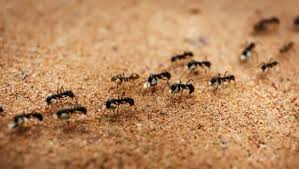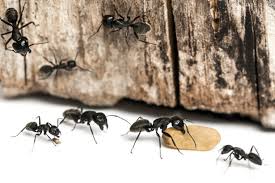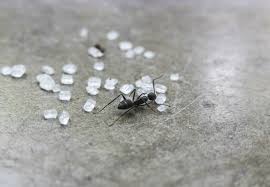What do ants look like?
Ants are common insects that inhabit every continent of the world except Antarctica. Though they come in different colors, they all have three body regions: the head with antennae, thorax, and abdomen. If you see flying ants, that means they’re mature males who will soon die after mating. Wingless ants are the ones that will infest your property.
At some point, it’s likely homeowners will need to know how to get rid of ants in their yard or residence. Ants are hardy insects that can easily make colonies in the ground and inside buildings. Not only can some species eat wood, but they can also cause painful bites.
While all ants can bite, not all species are likely to bite humans. Fire ants are the most aggressive species and are the most common biters. A blister with red spots forms soon after a fire ant bite. Carpenter, pavement, acrobat, field, and crazy ants can also bite humans when provoked repeatedly. It is usually easy to tell when you’ve been bitten by an ant because the area swells and has a stinging sensation.

What are ants doing in my house?
Ants are part of nature’s cleaning crew: they efficiently find and remove food left around the house. The problem is, sometimes humans don’t want their help.
You’ve probably noticed ants more commonly come indoors in summer – that’s largely because most insects are more active in the warmer months.
Ants occasionally come inside in search of water, particularly during dry periods. In this case you may see them in bathrooms or other humid parts of the house.
Heavy rains can also cause ant nests to flood and force them to relocate to nearby buildings, such as your house.

Home remedies for ants
So which home remedies and DIY solutions can you use for ants? Find out below!
Cinnamon
Cinnamon is often regarded as an effective DIY ant control option. It is believed that cinnamon acts as a natural repellent as ants can’t stand the smell.
This home remedy for ants involves using cinnamon essential oil as opposed to sticks or powder. It is believed that soaking a cotton ball in a solution of cinnamon essential oil and water and wiping down common ant hot spots, such as doors and windows, will help repel ants.
Will cinnamon get rid of ants?
Well yes, to a certain extent. A study in the International Journal of Scientific and Research Publications revealed that cinnamon essential oil can be used to both repel and exterminate ants.
However, there is a catch. The effectiveness of this DIY ant control solution depends on the concentration of the cinnamon oil, as well as the placement. For this home remedy to work, a high concentration of cinnamon oil needs to be used and it needs to be placed in the common areas where ants are entering your home. Identifying all the places where ants are exactly entering your home can prove difficult without proper training.
Vinegar
If you’ve read any of our other myth-busting DIY pest control tips, you’ll know that vinegar is often a common home remedy for insects. Ants are no exception.
To use vinegar as a home remedy for ants you simply need to fill a spray bottle with a solution of vinegar and water and apply it to the common ant hot spots and places where food is kept, such as cupboards and work surfaces.
Is vinegar a successful home remedy for ants?
Yes, but only for a short period of time. It is suggested that the aroma from vinegar masks an ant’s scent trail, preventing it from finding food. However, once the solution has evaporated it will no longer be an effective DIY ant control method.
To add to this, although it might help stop ants from finding food in the first place, it will have little to no effect on any infestation already in your home.
Lemon
Like vinegar, lemon is another home remedy for insects including ants. This DIY solution is thought to work as the acidic property of lemon juice masks ants’ scent trails and as a result, deters them.
For this DIY ant control option, rub lemon juice around door frames, window sills and other common entry points for ants.
Is lemon a successful home remedy for ants?
No, not really. Although lemon juice may seem like a successful home remedy for ants, it is not a foolproof solution. Yes, it may repel them for a short period of time, but in the long run, it has little to no effect.
Chalk
A common home remedy for ants is to use a piece of chalk to draw a border around the common entry points for ants.
It is thought that this works as ants won’t cross the chalk line, disrupting the scent trail.
Is chalk successful against ants?
No. Although it may disrupt an ant’s scent trail for a short period, the ants will soon find another way to continue on its hunt for food.

Carpenter Ant Control
Carpenter Ants are controlled through the application of insecticides and sprays in various forms. These forms include liquid concentrates, baits, dusts, and foams.
- Non-Repellent Insecticides – Used as perimeter spray.
- Baits – Used on Carpenter Ant trails.
- Dusts – Used in voids and galleries
- Foams – Used in voids and galleries
1. Inspection
The first step in controlling carpenter ants is an inspection. The purpose of the inspection is to determine if they are located outside and simply foraging inside for food, or if you have a colony or satellite colony inside your home.
2. Determine Control Measures
Once you complete your inspection and identify nest locations and foraging trails, the next step is to determine which control measure to use.
- Baiting – used on carpenter ant trails
- Spraying- Non-Repellent sprays used as permiter treatment, may be used with baits
- Treating Voids – Foams or Dusts used in voids or galleries where carpenter ants are nesting
3. Prevention
The final step is to prevent further infestations by ant-proofing your home and yard, by clearing away rotting trees and lumber piles, fixing plumbing leaks, etc.
Little Black Ant Prevention
Homeowners should consider working with a licensed pest professional to employ a preventative pest management plan. There are also a few things that can be done around the property to prevent a little black ant infestation.
Homeowners should seal cracks and crevices in exterior walls with a silicone-based caulk, ensure firewood is stored at least 20 feet away from the home, and keep shrubbery well trimmed. Location of the nest is also important. While it can be difficult to see these ants due to their small size, their nests can be found by following the trial of workers back to the colony.